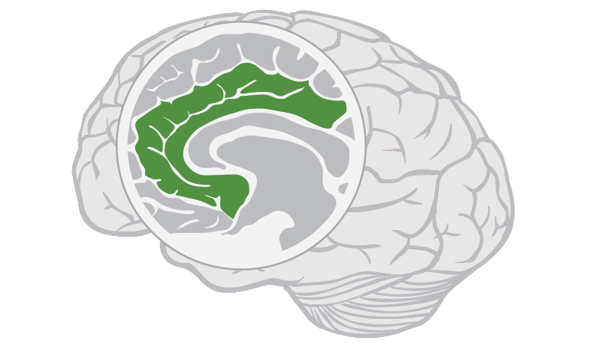
The limbic lobe is not a single brain structure, but rather an interacting group of brain structures that includes portions of each lobe of the cerebral cortex. This C-shaped brain region is vital for the functioning of memory, learning, motivation, and emotion, as well as endocrine functions and some autonomic—automatic, unconscious—bodily functions.
Although the limbic lobe, and the limbic system that it connects, substantially contributes to the emotions, self-awareness, and social skills that make us human, it is considered a primitive part of the brain. Much of the reactions that occur in the limbic system are unconscious, so an understanding of the limbic lobe may help scientists better understand involuntary and unwanted behaviors, such as compulsions, addiction, and mental illness.
Where is the Limbic Lobe?
The limbic system was once thought to be a discrete set of brain structures, but now we know that the limbic system involves a complex range of brain structures, as well as the hormones that affect these structures. Because hormone production and interaction can be affected by a range of environmental and genetic factors, the limbic system is inextricably linked to virtually every area of the body. Pain in a finger can trigger a limbic reaction. So too can a scent, a sound, or a visual image that calls to mind a memory.
The limbic lobe, by contrast, is a discrete set of brain structures—the same structures once thought to constitute the entirety of the limbic system. For this reason, a number of references may use the two terms interchangeably.
The limbic lobe is a C-shaped region that crosses brain hemispheres within the cortex, including portions of the temporal, parietal, and frontal lobes. All mammals have a limbic lobe. Which parts of the brain make up the limbic lobe is a subject for some debate, with some authors excluding structures that others include. Key components of the limbic lobe include the amygdala, hippocampus, mamillary body, and cingulate gyrus.
Other structures that are often attributed to the limbic lobe include:
- paraterminal gyrus
- subcallosal area
- parahippocampal gyrus
- dentate gyrus
- subiculum
- cingulate sulcus
- fasciolar gyrus
- fimbrodentate sulcus
- fimbria of hippocampus
- rhinal sulcus
- collateral sulcus
What Does the Limbic Lobe Do?
The limbic lobe plays a role in a range of complex emotional reactions. When most people think of emotions, they might think of simple reactions such as anger or sadness, but the complex and varied roles of the limbic system goes much deeper than just aiding people to understand or feel their emotions.
One of the most critical roles the limbic system plays is in the regulation of endocrine system responses to emotions, such as the adrenaline-based fight-or-flight response. Without any voluntary input, the limbic system triggers a reaction to perceived danger. It also regulates both conscious and unconscious functions such as sexual desire, some homeostatic mechanisms, and appetite. Other roles of the limbic system include:
- Attaching emotional significance to sensory experiences. The limbic system enables you to subjectively feel emotions; it also plays a role in automatic emotions, such as when the smell of a certain fragrance reminds you of your childhood or provokes an immediate negative reaction.
- Memory and learning. The hippocampus and other limbic structures play key roles in visual-spatial memory, as well as recollection, learning, and other forms of memory. Much of what doctors know about the limbic system's role in memory and learning comes from people who have suffered damage to the limbic system. Thus research on the limbic lobe's role in learning is incomplete, and may not fully account for how these structures work in healthy people.
- Social skills, empathy, and social processing. Damage to parts of the limbic system, particularly to the amygdala, can impede a person's ability to empathize, understand social cues, and interact in a socially appropriate fashion with others.
The limbic lobe and the systems associated with it are vital areas of interest to brain researchers, with hundreds of studies done on the region's functions each year.
How the Limbic Lobe Works With Other Structures
The limbic lobe and the various brain organs and regions it involves relies heavily on sensory input. Indeed, without such input, the limbic lobe can do little. Some of the myriad complicated ways it interacts with other regions of the body include:
- Processing sensory input from the eyes, ears, mouth, and skin, and applying meaning to that input. The limbic lobe also helps with the development of unconscious associations, such as the unconscious association between certain sights and smells and danger, pleasure, or other emotions.
- Gathering information from the surrounding world to make decisions. The limbic lobe is highly modifiable. Early experiences can heavily alter how it behaves. For example, early childhood trauma may lead to a more reactive limbic system, which can in turn affect hormonal regulation through the endocrine system, as well as virtually every other bodily system.
- Telling your body to secrete hormones in reaction to specific events, particularly emotionally salient ones.
- Affecting other bodily structures. For example, chronic stress can lead to a chronic fight-or-flight response that may lead your body to be flooded with cortisol, adrenaline, or other hormones. Over time, this can lead to a host of health maladies, including chronic inflammation, unexplained pain, and even infertility. Research into the connection between limbic dysfunction
- Regulating attention. The limbic system helps the brain determine what to focus on based on sensory input, as well as input from other regions of the body. For instance, the limbic system may play a role in the intense distraction that often comes with severe pain. Its role in focusing on survival during the fight-or-flight response is already heavily documented.
How Damage to the Limbic Lobe Can Affect Functioning
Damage to the limbic lobe can produce a wide range of symptoms. It's important to note that the damage does not have to be due to physical processes, such as head trauma or a brain lesion. Chronic stress, the wrong kinds of sensory input, and even a severely deprived developmental environment have all been associated with damage to the limbic lobe.
Sometimes the damage is reversible, and other times it can be mitigated or reversed. The prognosis depends on the source of the damage, how long the damage has persisted, quality of treatment, ongoing physical and occupational therapy, age, overall health, and a range of other factors. Like most brain regions, the limbic lobe is not fully understood, which means no doctor can make a prognosis with 100% accuracy. Some people spontaneously recover even with a terrible prognosis. Others make little to no progress even with competent medical care and minimal damage to the region.
Some possible effects of damage to the limbic lobe include:
- Epilepsy: Temporal lobe epilepsy is the most common form of epilepsy, and is often the product of damage to the limbic lobe.
- Hippocampal sclerosis: Usually a byproduct of temporal lobe epilepsy, hippocampal sclerosis causes severe damage to neurons and glial cells.
- Dementia: Damage to the limbic lobe can produce symptoms of dementia, including Alzheimer's and related disorders.
- Language issues: Some people with limbic lobe damage experience a condition called aphasia, which interferes with their ability to speak, understand language, or both.
- Changes in mood, personality, or impulse control.
- Disruptions in autobiographical or working memory that may change personality or behavior.
- Psychiatric disorders: Limbic lobe dysfunction is implicated in a number of psychiatric disorders, most notably bipolar, PTSD, and anxiety disorders. Often these disorders create a problematic feedback loop, damaging the limbic lobe and causing more symptoms. Those symptoms then further damage the limbic lobe, producing even more symptoms.
- Disorders in other areas of the body, particularly the endocrine system. Dysfunction in the limbic lobe can affect the manufacture and expression of a range of endocrine system hormones. Since virtually every bodily process depends on hormones to some degree, this damage can affect mood, personality, overall health, muscle tone, reproduction and fertility, sexual function, and even life expectancy.







